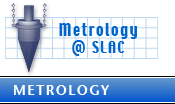RTK MappingRTK Technology at SLACGlobal Positioning System (GPS) results are dependent on the number and position of available satellites above the area being surveyed. Accuracy of a measured point is increased by better satellite geometry and the amount of time that a GPS receiver occupies a point. Up to a limit, the longer a point is measured, the better the accuracy of the determined position. Due to the extensive time needed on each point, conventional GPS presents a significant limitation to the feasibility of measuring many points in a short time. Thus mapping using conventional GPS is impractical. The solution is to conduct Real-Time matic (RTK) surveys that will allow for fast determination of point positions while maintaining a sufficient degree of accuracy.RTK is a method of surveying that allows for the use of GPS measurements from a well-determined station to be transferred to a rover thus providing real-time centimeter accuracy without long point occupation times. The necessary hardware consists of two or more GPS receivers and radio-modems. One receiver occupies a known reference station (such as SLAC M40) and broadcasts a correction message to one or more of the roving receivers. The roving receivers process the information from the reference station to solve for WGS-84 vectors by real-time integer solutions. This gives an accurate position of the rover with respect to the reference station. Clearly a well determined reference station is needed to produce accurate roving results. In terms of the time necessary for accurate data gathering, RTK allows a surveyor to occupy a point of interest for only a few seconds instead of the numerous minutes otherwise needed. RTK is a GPS differential mode of operation using the very accurate carrier phase measurements for point position determination. The phase observations require a preliminary ambiguity resolution before being useable. When phase lock is lost such as when measuring near trees or at a building corner, RTK can be limited in its ability to measure those points. Thus at SLAC we have added Leica’s DISTO system to our RTK package (Leica System 530 and RS 500). Combining RTK with traditional survey methods allows for the mapping of objects that would otherwise not be accessible by ordinary GPS methods. |
